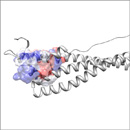The intrinsically disordered N-terminal region of AtREM1.3 mediates protein-protein interactions
Marín M, Thallmair V, Ott T (2012); Journal of Biological Chemistry
01.10.2012
 The long-standing structure-function paradigm, which states that a protein only serves a biological function in a structured state, had to be substantially revised with the description of intrinsic disorder in proteins. Intrinsically disordered regions that undergo a stimulus-dependent disorder-to-order transition are common to a large number of signalling proteins. However, little is known about the functionality of intrinsically disordered regions in plant proteins. Here we investigated intrinsic disorder in a plant-specific remorin protein that has been described as a signalling component in plant-microbe interactions. Using bioinformatic, biochemical and biophysical approaches we characterized the highly abundant remorin AtREM1.3, showing that its N-terminal region is intrinsically disordered. Although only the AtREM1.3 C-terminal domain is essential for stable homo-oligomerization, the N-terminal region facilitates this interaction. Furthermore, we confirmed the stable interaction between AtREM1.3 and four isoforms of the importin α protein family in a yeast two-hybrid system and by an in planta bimolecular fluorescent complementation assay. Phosphorylation of Ser66 in the intrinsically disordered N-terminal region decreases the interaction strength with the importin α proteins. Hence, the N-terminal region may constitute a regulatory domain, stabilizing these interactions.
The long-standing structure-function paradigm, which states that a protein only serves a biological function in a structured state, had to be substantially revised with the description of intrinsic disorder in proteins. Intrinsically disordered regions that undergo a stimulus-dependent disorder-to-order transition are common to a large number of signalling proteins. However, little is known about the functionality of intrinsically disordered regions in plant proteins. Here we investigated intrinsic disorder in a plant-specific remorin protein that has been described as a signalling component in plant-microbe interactions. Using bioinformatic, biochemical and biophysical approaches we characterized the highly abundant remorin AtREM1.3, showing that its N-terminal region is intrinsically disordered. Although only the AtREM1.3 C-terminal domain is essential for stable homo-oligomerization, the N-terminal region facilitates this interaction. Furthermore, we confirmed the stable interaction between AtREM1.3 and four isoforms of the importin α protein family in a yeast two-hybrid system and by an in planta bimolecular fluorescent complementation assay. Phosphorylation of Ser66 in the intrinsically disordered N-terminal region decreases the interaction strength with the importin α proteins. Hence, the N-terminal region may constitute a regulatory domain, stabilizing these interactions.
Reference:
Marín M, Thallmair V and Ott T (2012)
The intrinsically disordered N-terminal region of AtREM1.3 remorin protein mediates protein-protein interactions
Journal of Biological Chemistry; First Published on October 1, 2012, doi: 10.1074/jbc.M112.414292

